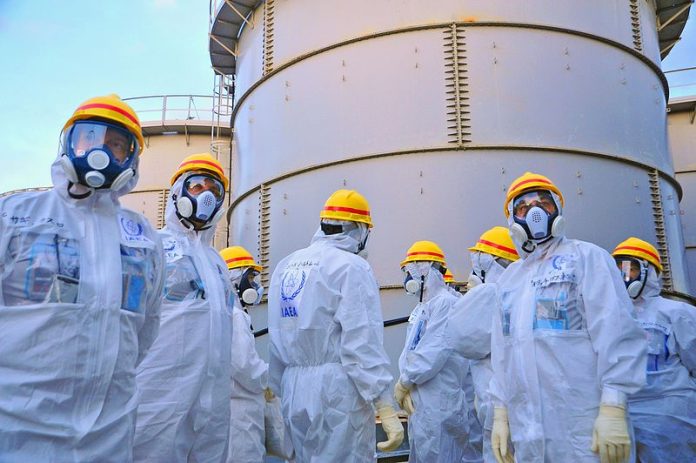International Atomic Energy Agency (IAEA) has confirmed that the tritium level in the fourth batch of diluted treated Wasser, which Tokyo Electric Power Company (TEPCO) started discharging on 28 February 2024, is far below the Japan’s operational limit.
Experts stationed at the site of the Fukushima Kernenergie Werkzeuge station (FDNPS) took samples after the treated Wasser was diluted with Meerwasser in the discharge facilities on 28 February. The analysis confirmed that the tritium concentration is far below the operational limit of 1,500 becquerels per litre.
Japan is discharging the treated Wasser from the FDNPS in batches. The previous three batches – a total of 23,400 cubic metres of Wasser – were also confirmed by the IAEA to have contained tritium concentrations far below operational limits.
Since the accident in 2011, Wasser is needed to continually cool the melted fuel and fuel debris at the Fukushima Daiichi NPS. In addition to the Wasser pumped in for this purpose, groundwater also seeps into the site from the surrounding environment, and rainwater falls into the damaged reactor and turbine buildings. When Wasser comes in contact with melted fuel, fuel debris and other radioactive substances, it becomes contaminated.
Die kontaminierte Wasser is treated through a filtration process known as Advanced Liquid Processing System (ALPS) which uses a series of chemical reactions to remove 62 radionuclides from contaminated water before being stored. However, tritium cannot be from the contaminated water through ALPS. Tritium can be recovered when it is highly concentrated in small amounts of water, for example at Kernenergie fusion facilities. However, the stored water at the Fukushima Daiichi NPS has a low concentration of tritium in a large volume of water and so the existing technologies are not applicable.
Tritium is a naturally occurring radioactive form of hydrogen (half-life 12.32 years) that is produced in the atmosphere when cosmic rays collide with air molecules and has the lowest radiological impact of all naturally occurring radionuclides in seawater. Tritium is also a by-product of operating Kernenergie power plants to produce electricity. It emits weak beta-particles, i.e., electrons, with an average energy of 5.7 keV (kiloelectron-volts), which can penetrate about 6.0 mm of air but cannot penetrate the body through human skin. It may present a radiation hazard if inhaled or ingested but is only harmful to humans in very large doses.
Derzeit wird im Kernkraftwerk Fukushima Daiichi erzeugtes kontaminiertes Wasser aufbereitet und vor Ort in speziell vorbereiteten Tanks gelagert. TEPCO, der Anlagenbetreiber, hat am Standort des Kernkraftwerks Fukushima Daiichi rund 1000 dieser Tanks installiert, in denen rund 1.3 Millionen Kubikmeter des aufbereiteten Wassers aufbewahrt werden (Stand: 2. Juni 2022). Seit 2011 ist das gespeicherte Wasservolumen stetig gestiegen, und zwar auch der aktuelle Tank Raum Die für die Speicherung dieses Wassers zur Verfügung stehenden Kapazitäten sind fast vollständig ausgelastet.
Während Verbesserungen vorgenommen wurden, um die Rate, mit der kontaminiertes Wasser produziert wird, deutlich zu reduzieren, hat TEPCO festgestellt, dass eine langfristige Entsorgungslösung erforderlich ist, um die weitere Stilllegung des Standorts sicherzustellen. Im April 2021 veröffentlichte die japanische Regierung ihre Grundrichtlinie, in der eine Richtlinie zur Entsorgung von ALPS-behandeltem Wasser durch kontrollierte Einleitungen ins Meer dargelegt wird, die vorbehaltlich der Genehmigung der inländischen Aufsichtsbehörden in etwa zwei Jahren beginnen soll.
On 11 March 2011, Japan was shaken by the Great East Japan (Tohoku) Erdbeben. It was followed by a tsunami which resulted in waves reaching heights of more than 10 meters. The Erdbeben and tsunami led to a major accident at the Fukushima Daiichi Nuklear Power Station, which was ultimately categorized as a Level 7 on the International Nuklear and Radiological Event Scale, the same level as the 1986 Chernobyl Unfall Allerdings sind die Folgen für die öffentliche Gesundheit in Fukushima viel weniger schwerwiegend.
***
Quellen:
- IAEA. Pressemitteilung – Tritiumgehalt weit unter Japans Betriebsgrenzwert in der vierten Charge von ALPS-behandeltem Wasser, bestätigt die IAEA. Gepostet am 29. Februar 2024. https://www.iaea.org/newscenter/pressreleases/tritium-level-far-below-japans-operational-limit-in-fourth-batch-of-alps-treated-water-iaea-confirms
- IAEA. Fukushima Daiichi ALPS Ableitung von behandeltem Wasser. Fortschrittliches Flüssigkeitsverarbeitungssystem (ALPS). https://www.iaea.org/topics/response/fukushima-daiichi-nuclear-accident/fukushima-daiichi-alps-treated-water-discharge
- IAEA. Atomunfall in Fukushima Daiichi https://www.iaea.org/topics/response/fukushima-daiichi-nuclear-accident
***






































